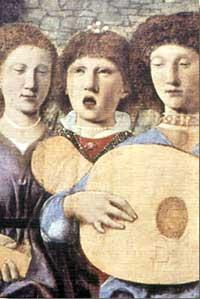Restoring fresh nanotechnologies

In the Renaissance many painters did not use the canvas. On the contrary, the technique of frescoes to paint on the walls of churches and palaces was the usual. This technique is complex and requires great skill. On the wall to be painted, wet plaster was applied and before drying the paint had to be extended. In this way, this painting was glued together with the plaster, that is, the painting became a component of the composition of the plaster.
With time and humidity, the frescoes gradually deteriorate. Normally some lumps are formed in the form of flakes in which the drawing loses softness and color. This is because with moisture lime (calcium oxide) becomes dead lime (calcium hydroxide).
Various techniques have been developed to treat these small lumps. One of the most effective is the fresh addition of tiny calcium hydroxide crystals in alcohols. As alcohol evaporates, crystals absorb water and carbon dioxide and melt with fresh matter.
However, for this technique to be effective it is necessary to stick very small crystals to the fresh. Those that can be purchased on the market are too large, so the team led by the chemist of the University of Florence, Piero Baglioni, has launched a system of making tiny crystals of calcium hydroxide.
Particles of almost molecular size up to 250 nanometers in length have been obtained. In addition, because they are flat particles, they quickly absorb water and carbon dioxide. To test the method, XVI. The fresh Gli Angeli Musicanti, painted by the painter Santi di Tito, was restored in the 19th century.
Buletina
Bidali zure helbide elektronikoa eta jaso asteroko buletina zure sarrera-ontzian











